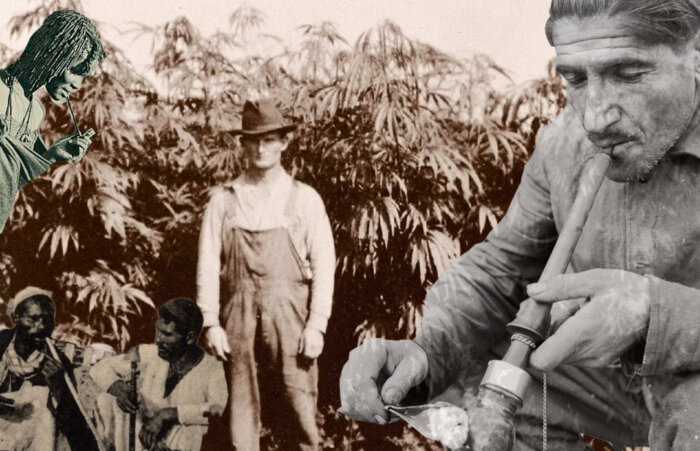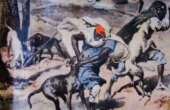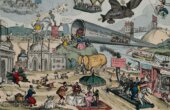A Brief Global History of the War on Cannabis

I want a Goddamn strong statement on marijuana … I mean one on marijuana that just tears the ass out of them. … By God we are going to hit the marijuana thing, and I want to hit it right square in the puss. … I want to hit it, against legalizing and all that sort of thing.
—Richard Nixon, 37th president of the United States
Before the war on drugs put marijuana farmers firmly in its crosshairs, cannabis was being grown openly and with commercial success on every continent on earth, much as it had been for centuries.
This ancient and extensive history of cannabis farming has given rise to the idea that prohibitions put in place in the mid-20th century were the first of their kind — a whirlwind of racial, political, and economic forces that successfully used marijuana prohibition as a pretext for suppression. By contrasting prohibition with our ancient history of cannabis farming, some historians make our modern-day drug laws appear irregular and shortsighted. In his seminal (and controversial) book on cannabis, “The Emperor Wears No Clothes” (referred to by many legalization advocates as “the Hemp Bible”), Jack Herer opens with the following line:
For thousands upon thousands of years, all over the world, whole families came together to harvest the hemp fields at the height of the flowering season, never dreaming that one day the U.S. government would be spearheading an international movement to wipe the cannabis plant off the face of the earth.
Yet, while unprecedented in scope, the United States’ war on drugs was not the first of its kind. The reality is that marijuana has been controversial for almost as long as humans have been farming it. Many societies throughout history have banned cannabis cultivation and use. What many of these crackdowns and prohibitions have in common is social and economic inequality, or a distrust of the unknown. When members of a minority or lower class embrace marijuana use, the ruling class moves to outlaw marijuana as a form of suppression and control. Marijuana is perceived to be a threat to the order of society, and stamping it out naturally begins with a prohibition on cultivation.
What many of these crackdowns and prohibitions have in common is social and economic inequality, or a distrust of the unknown.
As a case in point, the ancient Chinese might have been the first cannabis farmers — and, as far as we know, were the first to write about psychoactive marijuana — and yet they may also have been the first to reject it as a socially acceptable drug. The rise of Taoism around 600 BCE brought with it a cultural rejection of intoxicants. Marijuana was then viewed as antisocial, and derisively dismissed by one Taoist priest as a loony drug reserved for shamans. The sentiment persisted into the modern era — to this day, marijuana struggles to disassociate itself with the stained history of opium in China.
Muslim societies have a complex relationship history with marijuana. Hashish use spread widely with the expansion of Islam in the seventh century CE, and remains popular today. Early Arabic texts referred to marijuana as the “bush of understanding” and the “morsel of thought.” Yet traditional theologians believed Mohammed prohibited marijuana use (the Koran [2: 219] prohibits “intoxicants,” but how that word should be interpreted is still up for debate). One prominent theologian associated marijuana with the dreaded Mongol empire, and many upper-class Muslims pushed for prohibition, for fear that marijuana use would disrupt the labor force. In the end, some societies tolerated marijuana use or turned a blind eye; others (such as Damascus in 1265) embraced prohibition.

Sufi Muslims took these tensions to the next level. The mystical Sufis believed that spiritual enlightenment could be reached by an altered state of consciousness, and a mind-bending drug like marijuana would seem a logical vehicle to reach that state. Sufis believed hashish was a vehicle not only to personal enlightenment but to direct communication with Allah. These beliefs did not go over well with the rest of mainstream Islam, however. To make matters worse for the Sufis, they were often lower-class laborers. That marijuana use was therefore central to a religion perceived to be a heretical challenge to religious, economic, and political order made the plant an easy target for authorities.
In 1253, Sufis were openly growing marijuana in Cairo, Egypt. The government, claiming that Sufism was a threat to society, raided their farms and destroyed all their crops. Undeterred, the Sufis made deals with farmers in the Nile River Valley to grow marijuana on their farmlands. This successful agricultural partnership lasted until 1324, when Egyptian troops raided the countryside and destroyed all the marijuana they could find. For Sufis and marijuana farmers, the situation only got worse. Martial law was imposed in 1378, and this time the authorities destroyed more than marijuana crops: entire farms and farming villages were burned to the ground. Farmers were imprisoned or executed, and hashish users had their teeth pulled. Despite this swift and vicious crackdown, the demand for hashish remained strong. The cycle of cultivation, consumption, and crackdown continued in Egypt for centuries.
Islam was not the only major world religion to feel threatened by marijuana. Pope Innocent VIII issued a papal ban on cannabis in the first year of his papacy, in 1484. At the time, marijuana, along with other mind-altering plants, was being cultivated for medicinal and spiritual applications throughout Europe by pagans who were considered to be witches and sorcerers. The Christianity of Pope Innocent VIII, however, was predicated on a future fulfillment in the afterlife, and a rejection of momentary pleasures or enlightenment. The pagans growing marijuana profoundly challenged this premise by promising spiritual enrichment in the present, with a plant grown right here on earth. Pope Innocent VIII thus wasted no time in addressing this existential threat, declaring cannabis to be an unholy sacrament of the satanic Mass. The pagans who cultivated it were persecuted into imprisonment, exile, or death.
In 1253, Sufis were openly growing marijuana in Cairo, Egypt. The government, claiming that Sufism was a threat to society, raided their farms and destroyed all their crops.
Colonial empires, with their unfailing concern for a robust military and hard-working labor force, have often viewed marijuana with suspicion. Though the Spanish were one of the first colonial empires to encourage the cultivation of hemp in the Americas, they were not as enthusiastic about marijuana. The Spanish governor of Mexico issued an order in 1550 limiting cannabis farming because “the natives were beginning to use the plant for something other than rope,” write Robert Clarke and Mark Merlin in their book “Cannabis: Evolution and Ethnobotany.” White South Africans, descended from Dutch or British colonialists, passed a series of laws in the 19th century designed to crack down on the cultivation and use of marijuana by indentured Indian farmworkers, who were viewed by whites as societal contaminants and a threat to civil order.
The Portuguese empire also struggled to control cannabis. The Portuguese wanted to foster a strong hemp-producing workforce just like those of their colonial rivals, but they considered marijuana a pernicious vice, especially when used by slaves. The Portuguese introduced marijuana prohibitions to many of their African colonies, including Zambia and Angola. Nonetheless, explorers to the region noticed marijuana being grown “nearly everywhere” and used by “all the tribes of the interior,” according to a report published by the Transnational Institute.
When the Portuguese brought slaves to Brazil in the 16th century, the slaves brought marijuana along with them, as seeds were sewn into the clothing they wore onto the slave ships and then germinated upon arrival. Whatever strains they were using must have been well adapted to the Brazilian landscape; marijuana was soon growing from the coasts to the Amazon and everywhere in between. For the most part, marijuana cultivation was permitted during Portuguese rule. But when Brazil gained its independence in the early 19th century, Rio de Janeiro’s municipal cannabis prohibition started a chain reaction of prohibitions around the country aimed at curbing marijuana use among slave populations.

One reason Portugal may have been lenient on marijuana farming in Brazil is the fact that the Queen of Portugal herself was using it while stationed there during the Napoleonic wars. This wasn’t the first time Napoleon Bonaparte was involved in the history of marijuana. Several years earlier, in 1798, Napoleon had launched the French campaign into Egypt and Syria, a large-scale offensive designed to cut off British trade and liberate Egypt from Ottoman rule. After the initial conquest, Napoleon attempted to maintain local support by embracing Islamic culture and scientific exchange. An unusually large percentage of French forces in Egypt (totaling around 40,000) were scientists and scholars, and were responsible for establishing libraries, laboratories, and research centers that went on to make significant contributions in a number of disciplines.
The discovery of hashish may not have been seen as a breakthrough at the time, but it had a great effect on European culture and literary thought. Prior to the French campaign in Egypt, hashish wasn’t well known in Europe and certainly wasn’t commonly used. The 40,000 French troops stationed in Egypt, however, quickly learned about it. Hashish was ubiquitous in Egypt at the time, bought and sold in cafés, markets, and smoking lounges. Lacking access to their customary French wines and liquors and encouraged by Napoleon to embrace Egyptian culture, many French troops took up hashish.
Unfortunately, hashish was still associated with Sufi mystics and looked down upon by the Sunni elite. After Napoleon went back to France, the general he had left in charge of Egypt, General Jacques-François Menou, was a noble-born French revolutionary who married into an upper-class Sunni family after taking command of Egypt. For Menou, the prospect of a hashish ban killed two birds with one stone: It would appease the Sunni elite by cracking down on Sufis, and alleviate a perceived public health problem among the French troops. The ordre du jour banning the cultivation, sale, and consumption of cannabis, considered by some scholars to be the first drug prohibition law in the modern era, came down in 1800. It opens with the following:
Article One: The use of strong liquor, made by certain Muslims with a certain grass [herbe] called hashish, and smoking of the seed of cannabis, are prohibited throughout Egypt. Those who are accustomed to drinking this liquor and smoking this seed lose reason and fall into a violent delirium, which often leads them to commit excesses of all kinds.
Whether or not Menou’s order was the first modern penal law on drugs, it largely failed to work (a fact that should come as no surprise to us in the 21st century). Hashish continued to be produced, sold, and consumed widely throughout Egypt, and it came home with French troops when they left Egypt in 1801. It wasn’t long before hashish was being widely used in France and the rest of western Europe.
Despite efforts by authorities in Europe to paint hashish as an unstable and dangerous substance, many of the Romantic period’s most accomplished artists and writers were brought together because of cannabis. Dubbing themselves Le Club des Hachichins (Hashish-Eaters’ Club), luminaries such as Théophile Gautier, Charles Baudelaire, Gérard de Nerval, Victor Hugo, Honoré de Balzac, and Alexandre Dumas would meet in Paris to take hashish and exchange notes on their experiences. They rejected mainstream attempts to associate hashish with what was regarded as Oriental barbarism and, through their writings, normalized marijuana use and popularized the Romantic era’s bohemian creed: l’art pour l’art (art for art’s sake).

Across the Channel, the British Empire wrestled with the conspicuous presence of cannabis in India. As a native plant to the Indian subcontinent, cannabis could be found growing in the wild by hunter-gatherers, and was likely cultivated by the earliest agrarian settlers. Psychoactive marijuana strains featured prominently in early texts of the Hindu, Buddhist, and Tantrist religions. As the Indian marijuana farming industry matured over time, the harvested product was divided into three gradients, all of which remain available today.
Bhang is the cheapest, most prevalent, and lowest-quality marijuana; it consists of crushed leaves, seeds, and/or flowers, and produces the least potent high. On the other end of the spectrum, Charas is the highest-quality and most expensive marijuana in India. It is sold as a highly potent hashish produced from plants grown in the most desirable cannabis-producing farmlands of the Hindu Kush and Himalaya mountain ranges between 4,000 to 7,000 feet. It remains one of the most revered marijuana products in the world today. Somewhere in between Bhang and Charas is Ganga. A mid-grade crop in both price and potency, Ganga is cultivated from well-cared-for female plants, and consists of a mixture of resin and cannabis flower.
One of the first Europeans to write about the Indian marijuana industry was a Portuguese doctor named Garcia da Orta. He wrote of Bhang in 1563:
The Indians get no usefulness from this, unless it is in the fact that they become ravished by ecstasy, and delivered from all worries and cares, and laugh at the least little thing. After all, it is said that it was they who first found the use of it.
Some 200 years later, the British mulled over the possibility of a marijuana prohibition in India. The Indian ruling class and the British governor-general of India pushed for a total ban, fearful that marijuana would create social unrest. The British Parliament, however, had other ideas. Short on cash, the government saw the marijuana industry as an opportunity to raise some revenue. They taxed cannabis in 1790, and three years later, established a regulatory framework to issue licenses to farmers and sellers.
The tax-and-regulate scheme worked to some extent. But in a vast landscape where cannabis grows in the wild, many farmers and their crops escaped the tax. The British encouraged the regulatory system to decentralize, allowing cities and states to experiment with different taxation schemes. The results were mixed. The strength of the black market was frustrating enough that the British Parliament considered prohibition measures in 1838, 1871, 1877, and 1892. But ultimately the measures failed to pass, because the tax revenues that did come in couldn’t be ignored.
Temperance movement advocates persisted, however, driven by the evils of opium use which they associated with cannabis. Parliament responded by commissioning the most comprehensive government study of marijuana in human history. The seven-volume 3,500-page “Report of the Indian Hemp Drugs Commission” of 1894 to 1895 called over a thousand witnesses from around the world. The findings emphatically rejected the alleged grounds for prohibition. The commission found (as its predecessors did) that marijuana cultivation is nearly impossible to eradicate, and argued that it produces no “evil results” in the first place:
Total prohibition of the cultivation of the hemp plant for narcotics, and of the manufacture, sale, or use of the drugs derived from it, is neither necessary nor expedient in consideration of their ascertained effects, of the prevalence of the habit of using them, of the social and religious feeling on the subject, and of the possibility of its driving the consumers to have recourse to other stimulants or narcotics which may be more deleterious.
The commission went on to recommend a tax-and-license scheme for the marijuana farming industry:
The means to be adopted for the attainment of [control and restriction] are:
• adequate taxation, which can be best effected by the combination of a direct duty with the auction of the privilege of vend;
• prohibiting cultivation, except under license, and centralizing cultivation.
This may represent the first time in history a government study has recommended a centralized marijuana farming scheme. Comprehensive as it is in other respects, however, the commission’s report does not elaborate on this centralization proposal; it merely suggests that the most effective way of limiting supply is “to grant licenses for cultivation in such a way as to secure supervision and registration of the produce.”
Despite the commission’s efforts, Parliament’s endorsement of its report was lukewarm. As a result, the marijuana farming trade continued unchanged, with taxation and licensing of cultivators continuing to be hit and miss. Bhang was informally grown nearly everywhere; Ganga crops were, for the most part, produced on government-licensed farms; and Charas was imported from the Hindu Kush and Himalayas. This basic structure persisted into the global prohibition era of the 20th century. The proposal to “centralize cultivation” was largely forgotten after the commission’s report was published. But a century later, government regulators trying to find their way through the post-prohibition era of the 21st century would come to recognize its advantages.
The history of marijuana farming tells us that when prohibitions are imposed, they almost always come from the ruling class. Marijuana’s role as a spiritual, medicinal, or recreational drug of the poor working classes stokes fears among the elite that the political, religious, or economic order that has served them so well may be disrupted. There aren’t, therefore, many cases where marijuana was embraced by the ruling class and persecuted from below. But the story of the Bashilange tribe suggests that marijuana users can be targeted from any angle.
In the mid-19th century, the eastern region of the Democratic Republic of the Congo in central Africa was a vast wilderness, and it was controlled by the Bashilange tribe. The Bashilange were ruthless fighters, eating the bodies of their victims and enslaving their prisoners. They enacted few laws, save a requirement that other tribes in the region pay tribute to their supremacy or face a certain death. While exploring these lands, however, the Governor of German East Africa observed a remarkable shift in the Bashilange’s culture. The tribe had discovered marijuana, and rapidly embraced the plant as a pillar of their tribe’s identity.
The history of marijuana farming tells us that when prohibitions are imposed, they almost always come from the ruling class.
Tribesmen of the Bashilange dubbed themselves the Sons of Cannabis, and soon passed laws to promote peace and friendship. They rejected cannibalism and were no longer permitted to carry weapons in the village. They stopped killing their rivals, and started having more sex. Marijuana was smoked regularly and at most important events, including religious ceremonies, holidays, and political alliances. Formerly known for being cold-blooded killers, the Sons of Cannabis became tranquil marijuana-growing peacemakers.
Unfortunately, their rivals did not share the Sons of Cannabis’s newfound love of peace and friendship. Many tribes lost respect for their former rulers and stopped making tribute payments. With weakening support in the region, the Bashilange tribe splintered. The Sons of Cannabis, no longer the fearsome fighters of yore, were overthrown by their fellow tribesmen who yearned for a return to the tribe’s dominant past. The new regime reinstituted the tribe’s violent practices, and largely returned the Bashilange to its former warring nature.
Jack Herer may have been using hyperbole when he claimed that cannabis farmers throughout history could not have conceived of the 20th century’s crackdown on marijuana. The historical record illustrates that while many regions of the world have tolerated or embraced marijuana farming in the past, plenty of others have seen authorities attempt to exterminate farmers and their crops. Targeting the first step in the supply chain is a logical starting point for prohibitionists, and marijuana’s role as an agent of religious, political, or economic change has long made it a threat to the established social order.
Our marijuana-farming ancestors of the past could have told us, based on experience, that when prohibitionists come after cannabis, they will do so in predictable ways. They will use rhetoric to associate the plant with violence, depravity, and other more dangerous drugs, as the European temperance movement did in France and Great Britain. They will use a militarized show of force to eradicate crops, persecute farmers, and dissuade the next generation from growing marijuana, as the Ottomans did in Egypt. They will portray marijuana users as religious extremists or dangerous minorities, as Pope Innocent VIII did in Europe, Sunni Muslims did in the Middle East, or white South Africans did in South Africa. The best-case scenario, they might say, is that the authorities will turn a blind eye to the unstoppable forces of supply and demand, much as the Portuguese did in Brazil or the British did in India.
In telling us this, our marijuana-farming ancestors might as well have been writing the playbook for the 20th-century war on drugs. The cannabis prohibition era in the United States did not invent this “greatest hits” collection of tactics that prohibitionists have been using for centuries; it simply brought them all together in one place, and injected them with more financial and military resources than any prohibition movement in history has ever seen.
Ryan Stoa is an associate professor of law at the Concordia University School of Law and the author of “Craft Weed,” from which this article is adapted.



